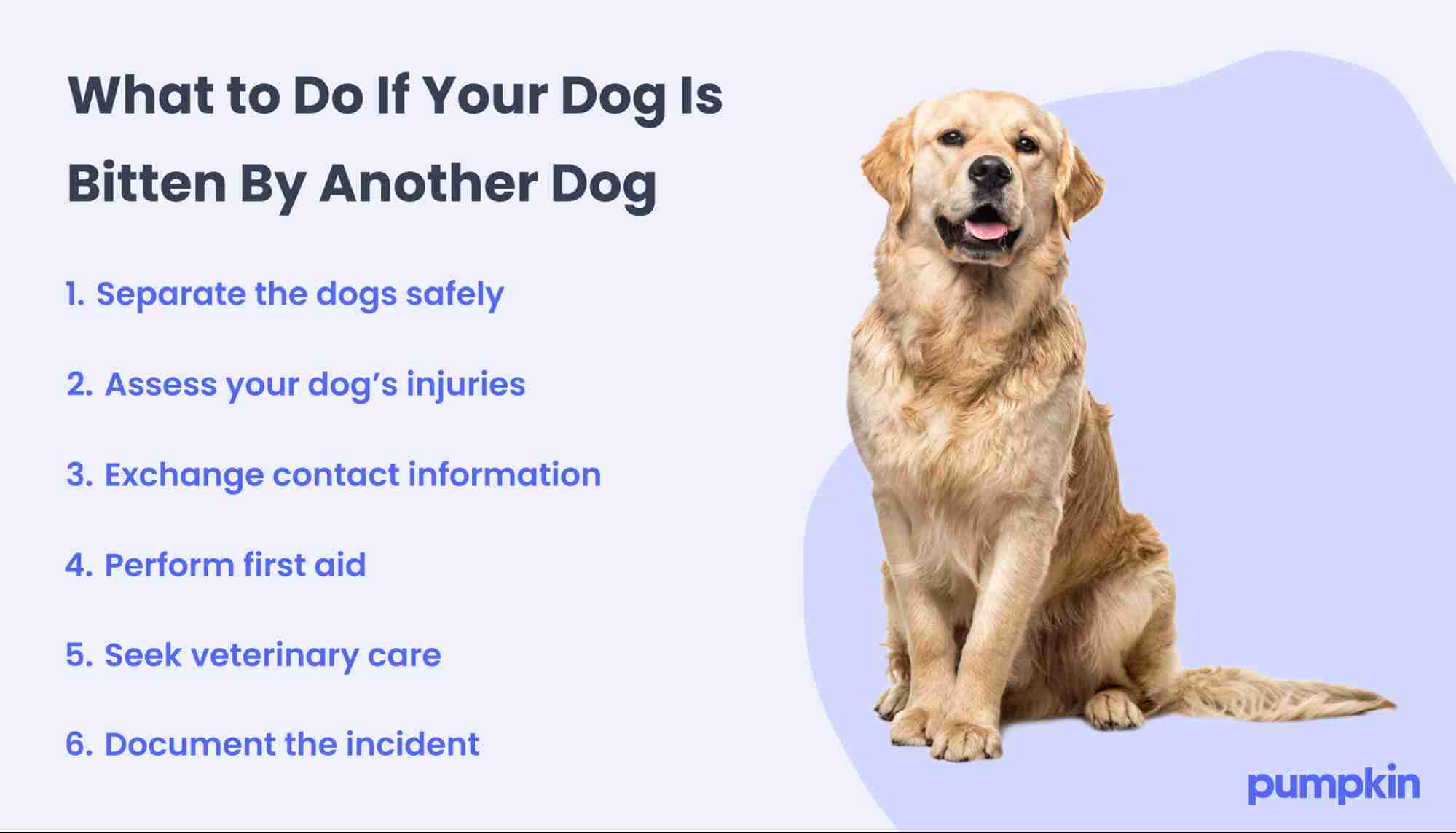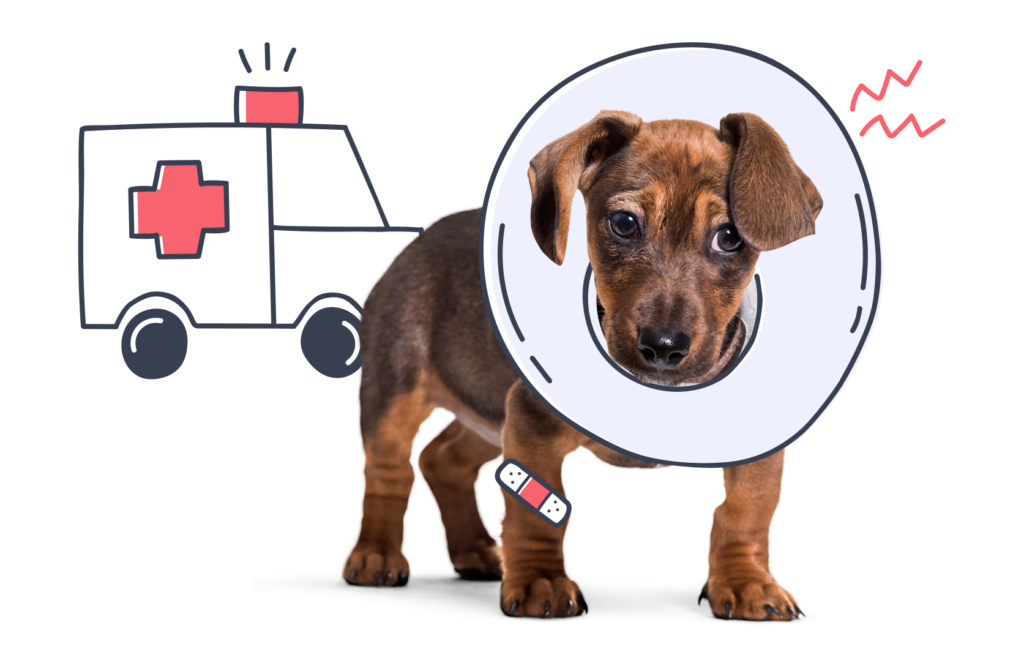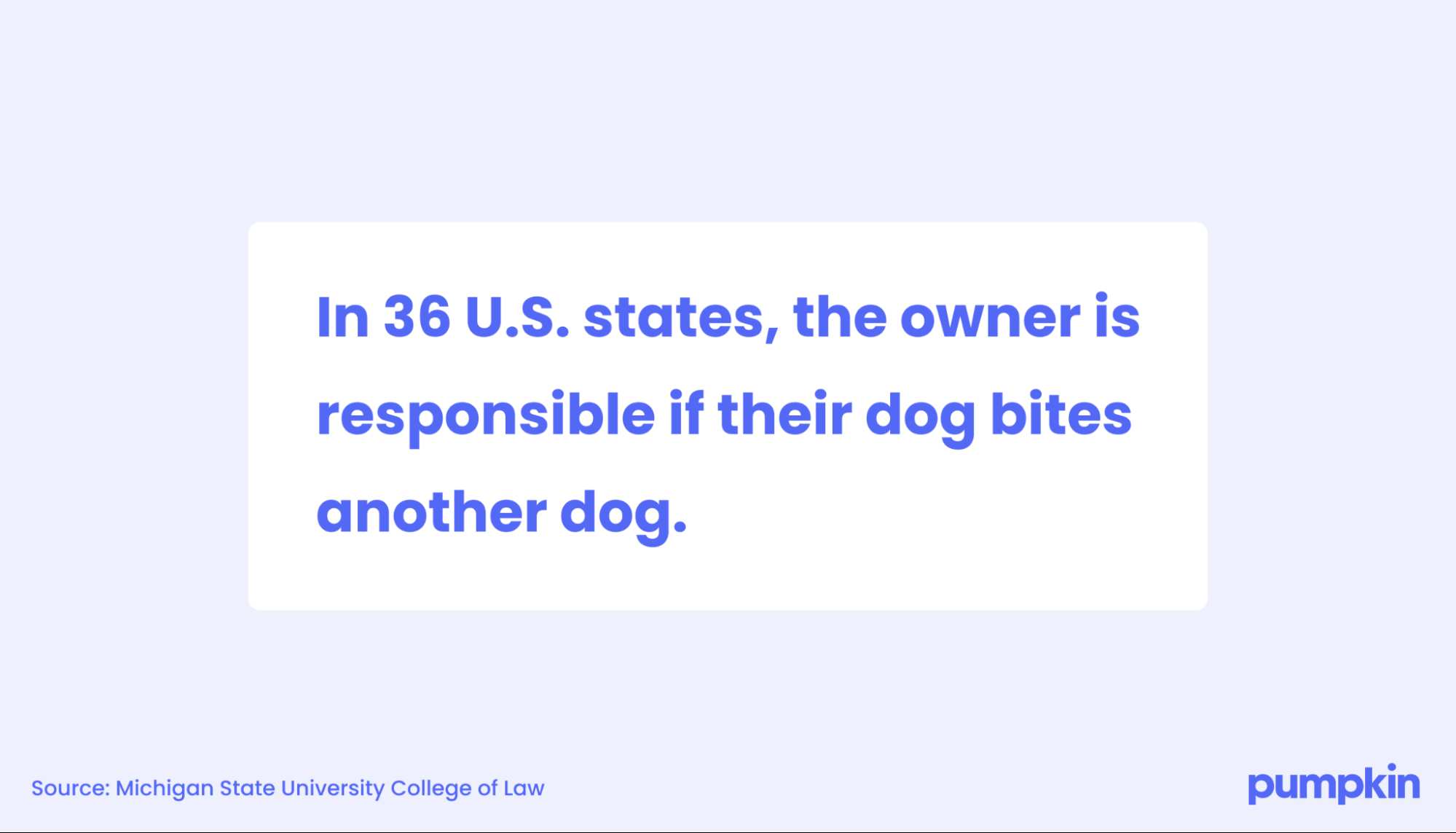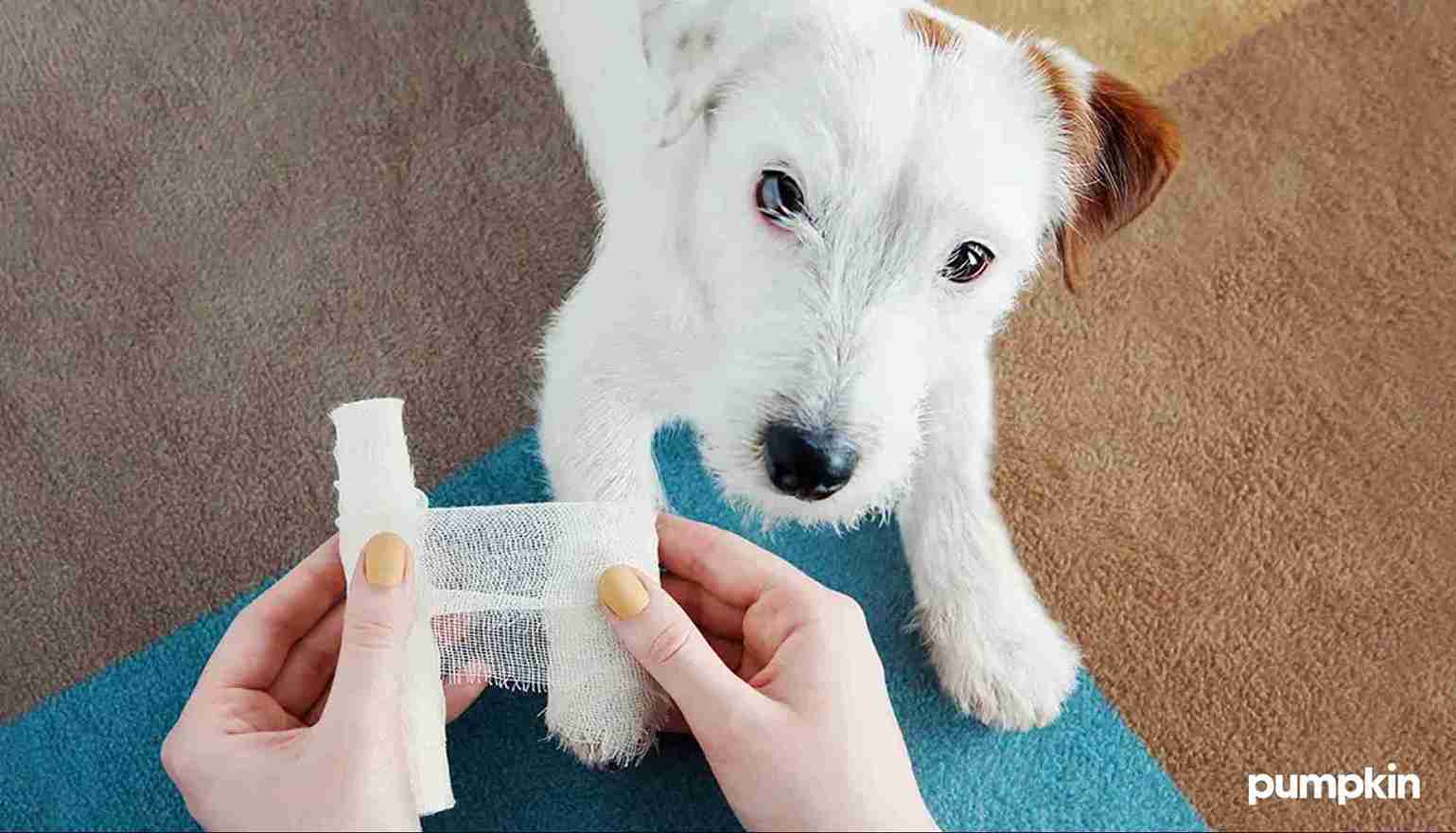Key Points
- Proceed with great caution when attempting to break up a dog fight and when assessing your pup’s wounds.
- The extent and location of injuries will determine the exact treatment plan, but most dog bites are treated with bandages, stitches, and antibiotics to stop infection.
- Psychological recovery may take longer than physical recovery. Take your time reintroducing your dog to social situations, as pups often exhibit anxiety after a frightening experience.
- If your dog initiated the fight, invest in animal training to help socialize them around other dogs.
Your afternoon dog park adventure just took a turn for the worst: your dog got bit by another dog. You’re likely feeling scared and frazzled — and seeking immediate help for your pup.
When your dog is bitten by another dog, it’s natural to feel panicked, but taking the right steps quickly can make all the difference. From safely separating the dogs to assessing injuries, staying calm and focused is key to helping your pet.
Read on for step-by-step advice on what to do when your dog gets bitten by another dog. You’ll also hear from several veterinarians with experience treating dog bite wounds.

1. Separate your dog – but use caution
There’s no doubt you’re worried for your furry friend, but staying as calm as possible during a dog fight and its aftermath will help keep you and your dog safe.
Any attempt to separate quarreling dogs should be undertaken with great caution. Most veterinary professionals will tell you to never come between two fighting dogs. Trying to intervene directly when a dog is bitten by another dog can leave you seriously injured.
“Do not put yourself at risk,” warns veterinarian and behaviorist Dr. Paola Cuevas, MVZ. “A dog that is already biting another dog will also bite you.” She advises that both dog owners evaluate the situation and work together to find a safe way to stop the fight. “If there’s a hose nearby, try spraying water to distract and separate the dogs.” Dr. Cuevas says another option is to use a physical barrier — like a broom, garbage can lid, or slab of wood — to break up the fight and protect yourself at the same time. You can also throw a blanket over the dogs.
As a last resort, Dr. Cuevas suggests you “work with a second person to grab each dog’s hind legs and pull backward — so they move like wheelbarrows in reverse.”
This awkward motion can debilitate the dogs for long enough to give both owners the chance to separate them, and for you to get your dog to safety. She emphasizes the importance of protecting yourself from harm and avoiding anything that might escalate the situation, like making eye contact with the other dog or reacting in anger toward its owner.
2. Find a safe spot to assess injuries
Once you’ve separated your dog, find a secluded spot where your pup can quiet down. If they can walk, guide your dog carefully while assessing the bite on your dog and looking for signs of injury. Wait until they’re calm to examine their body for bite wounds, puncture marks, and any other injuries — and try your best to keep calm, too.
Dr. Jamie Whittenburg, DVM, director of Kingsgate Animal Hospital in Lubbock, TX, and veterinarian at Senior Tail Waggers, advises that you “inspect your dog for injuries but do so cautiously, as an upset dog in pain is likely to bite anyone that touches them.” That includes you. “When dogs are scared, hurt, or have an adrenaline rush,” Dr. Whittenburg says, “they may bite even their favorite human.”
3. Exchange contact information
As eager as you are to seek care for your pup, before hightailing it from the scene of the fight, try your best to get the other dog owner’s name and contact information. Knowing their dog’s vaccine status will help you determine if your pet needs a rabies vaccine booster shot.
If the other dog owner is uncooperative or absent, take pictures and video with your phone to help document the situation.
4. Perform first aid if necessary
Some bleeding will require you to administer first aid before you reach the vet. In these cases, Dr. Whittenburg recommends that you hold pressure over the wound with a dry, clean cloth.
Some other first-aid steps to take after a dog bite include:
- Clean the wound gently
- Apply a dog-friendly antiseptic
- If the bite is on a limb, keep it as still as possible to prevent further damage or pain
- Wrap your dog in a blanket to prevent shock and provide comfort
- Avoid applying creams, ointments, or bandages not specifically designed for pets
Immediately take your dog for emergency care if they are showing any of these severe or life-threatening signs:
- Uncontrollable bleeding
- Difficulty breathing
- Weakness or limping
- Crying or whining
- Blue or pale gums

5. Arrange veterinary care
If your dog got bit by another dog, the extent of their bite injuries isn’t always obvious. Regardless of how severe the bites look, it’s best to make an urgent appointment with your vet or head to the nearest emergency veterinary hospital as soon as possible. Even the smallest bite can pose a serious risk of infection.
“A seemingly minor dog bite can result in several complications, including cellulitis, sepsis, bone and joint infections, and peritonitis,” Dr. Whittenburg cautions. “Crush injuries, broken bones, and damage to the delicate structures in the neck can also easily be missed without a veterinarian’s expertise.”
A dog’s teeth are powerful and can tear through skin and muscle easily, sometimes causing serious or fatal damage to the organs. While it might be a no-brainer to call the vet when your dog is visibly bleeding, bite marks that look superficial — or that are beneath your dog’s coat — can still be dangerous to your pet.
“Teeth often make slim but deep punctures that can be difficult for owners to evaluate appropriately,” Dr. Whittenburg says. “Because a dog’s mouth is full of bacteria, these penetrating injuries can easily abscess and turn into severe infections without proper treatment.”
What will happen at the vet?
Your vet will conduct a thorough evaluation to determine how serious the injuries are and what treatment will be necessary.
While every dog puncture wound is different, here are steps a vet will typically take during the visit:
1. Initial assessment
First, the vet will do an overall health check to evaluate your dog’s condition. This includes checking vital signs such as heart rate, breathing, and hydration levels to determine the severity of the situation. If your dog is in an unstable condition, your vet may administer fluids to facilitate hydration and manage blood pressure.
2. Inspection of wounds
The vet will examine your dog’s injuries, paying close attention to the depth of the puncture wounds and assessing the potential for infection and abscess. They will also check for other signs of injury, including broken bones, contusions, and nerve damage.
Injuries on certain areas of your pet’s body — the neck, torso, and limbs, for example — are more likely to cause complications and can largely determine the kind of medical treatment necessary. To check for internal injuries or complications that aren’t immediately visible, the vet might order diagnostic imaging such as ultrasounds or x-rays.
3. Wound treatment and cleaning
The vet will clean and disinfect the wound to prevent an infection or reduce its severity. In more severe cases, the vet may surgically remove damaged tissue and insert a drain to prevent fluid from pooling and causing infection. They could recommend sedation or anesthesia if wounds need cleaning and suturing.
4. Dressing the dog bite wound
Your veterinarian will dress the wound to promote healing and protect it from further damage. This may involve applying sutures, bandages, or other protective coverings to keep the area clean.
If stitches or bandages are applied, your dog will probably leave the vet with an Elizabethan collar. Less regal than the name suggests, the plastic-shaped cone worn around your dog’s neck is an uncomfortable necessity.
Dr. Cuevas notes that the collar is an important tool that “helps to make sure your dog does not lick their wounds,” which could not only delay healing but result in infection or injury.
Recovery plan at home
Your dog will likely require ongoing treatment after the vet visit, and the physical recovery process will probably last a couple of weeks. Along with a lot of TLC, it’s important to follow the prescribed care plan to ensure your pup heals properly.
Medication
An anti-inflammatory and pain medication are likely to be a part of the treatment regimen to manage your dog’s discomfort and reduce swelling. If your dog’s wounds have penetrated the skin, the vet may prescribe a broad-spectrum antibiotic as well.
It’s essential to give your dog the full round of antibiotics – do not stop the medication early, even if your pup seems to have recovered.
Dog collar
If your dog was given an Elizabethan collar, keep them in a confined space or room while wearing it. Remove any objects your disoriented pup could easily knock over to mitigate discomfort and prevent more injuries. This will help ease the fear dogs can experience when their collar bangs into furniture and other objects.
Wound care
Wound areas closed with sutures should be kept clean and dry. If the wound was left open to heal, or a drain was placed inside it, make sure to clean the area regularly.
Remove debris or residue with a soft washcloth or cotton balls and warm water. Do not use a cleanser or disinfectant unless prescribed by the vet.
Many experts recommend you place a muzzle over your pet’s mouth and nose when caring for their wounds since even the gentlest dogs might bite out of pain or fear.
Psychological recovery plan
Unfortunately, the psychological recovery process may take longer than a couple of weeks. Pet parents whose dogs have been in a fight should expect them to take some time to feel comfortable around other dogs and in social situations.
If your pup starts to act aggressively toward other dogs after suffering an attack, then use these approaches as part of the psychological recovery process:
- Gradually reintroduce your dog to other pets by starting with familiar, well-behaved dogs in a controlled environment
- Keep interactions short and positive
- Reward calm behavior with treats and praise to help your dog associate good experiences with social interactions
- Take your dog on controlled walks in quiet areas and slowly expose them to more stimuli as they grow comfortable
If fear or aggression persists, consult a certified canine behaviorist or trainer for a tailored recovery plan.
Understanding dog bite laws
Dog bite incidents can have serious legal implications for both the owner of the dog and the person bitten. Being aware of the laws in your area is essential to ensure everyone’s safety and hold irresponsible dog owners accountable.
Dog bite laws vary across states, with some enforcing “strict liability” and others following the “one-bite rule.” Certain states have additional regulations for “dangerous” or “vicious” dogs, requiring owners to take extra precautions, such as using a muzzle. In many areas, reporting a dog bite to animal control or the police is mandatory.

Victims of a dog bite may have the right to seek compensation for their injuries, and owners who fail to follow local laws or properly control their dogs could face fines or other penalties.
Does pet insurance cover dog bites?
Pet insurance does not cover pre-existing conditions or routine care like vaccinations. Rather, it covers the costs of care related to unexpected accidents and illnesses. That means most pet insurance plans will cover a dog bite, though the decision will always be made on a case-by-case basis.
If your dog bites another dog, your pet insurance will not cover the costs of the other dog’s care, though your homeowner’s insurance might.
How to avoid future dog fights
Whether your dog was bitten or was the one that started the fight, proactive steps can help prevent future incidents.
Keep your dog leashed
Dog attacks and fights are much less likely to occur when pups are leashed, especially on walks and in public parks. Keeping your dog on a leash ensures you have control and can avoid unplanned interactions, whether it’s aggression from your dog or another.
Be mindful at dog parks
If you enjoy visiting dog parks, pay attention to the environment on any given day. Not all pups are comfortable around a large number of dogs or people. It’s probably best to avoid a crowded, chaotic scene if your pooch generally prefers a low-key setting.
For dogs that get nervous in hectic spaces with lots of stimuli, spend more time playing together at home or walking down quieter streets in your neighborhood. You may also want to avoid breeds like Pit Bulls, which are responsible for more dog bites than any other breed; attacks by bit pulls are also more likely to result in serious injury or death.
Focus on training and socialization
Well-mannered dogs tend not to fight as often as those without training, so enrolling your pet in dog training classes at a young age is a great preventive measure. Consistent socialization in controlled environments can help your dog become more comfortable and calm around others.
If your dog has behavioral issues or has problems with food aggression, take steps to manage and reduce this behavior. Professional trainers or behaviorists can help address underlying issues and teach your dog appropriate behaviors toward other dogs, pets, and people.
Avoid dogs showing signs of aggression
Keep your distance from dogs exhibiting anxious or aggressive behaviors like lunging, growling, and snarling. If you’re out and see an unleashed dog roaming an area, do not approach it. Fido might be gentle, but you don’t know the other dog’s temperament.
Be prepared for the unexpected
Accidents like a dog bite can happen in an instant, and being prepared makes all the difference. Knowing how to treat a dog bite on a dog and how to care for your dog physically and emotionally can help them recover from a traumatic injury.
While prioritizing your dog’s safety, don’t let unexpected vet bills add to the stress. Learn more about how a Pumpkin Dog Insurance plan can help protect your pup when they face future accidents and injuries.
FAQs
- https://www.nolo.com/legal-encyclopedia/dog-bites-other-injuries
- https://www.animallaw.info/content/state-dog-laws
- https://www.findlaw.com/injury/torts-and-personal-injuries/dog-bites-animal-attacks.html
- https://www.avma.org/resources-tools/one-health/rabies
- https://www.forbes.com/advisor/legal/dog-attack-statistics-breed/



